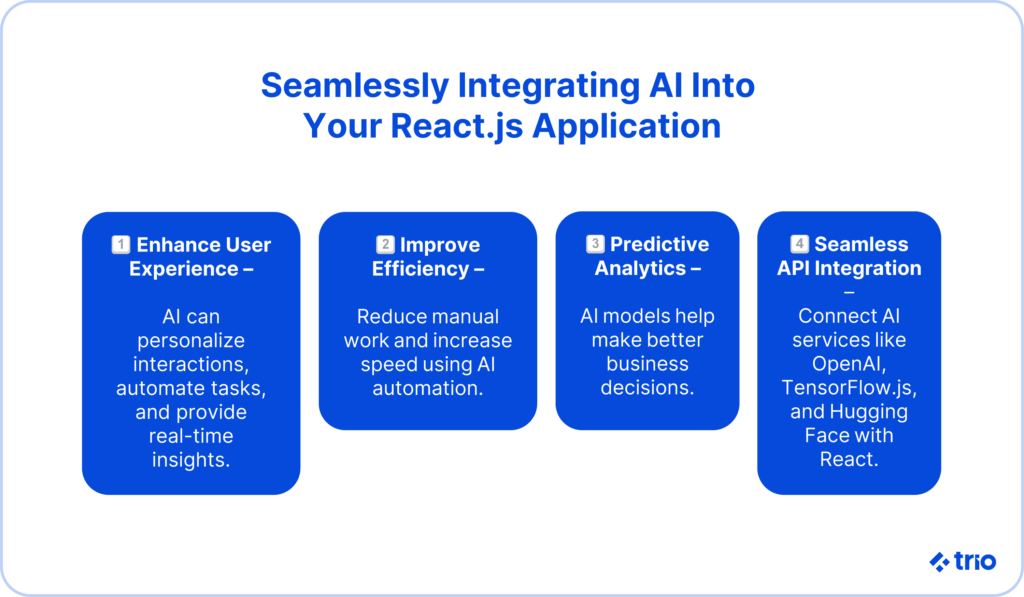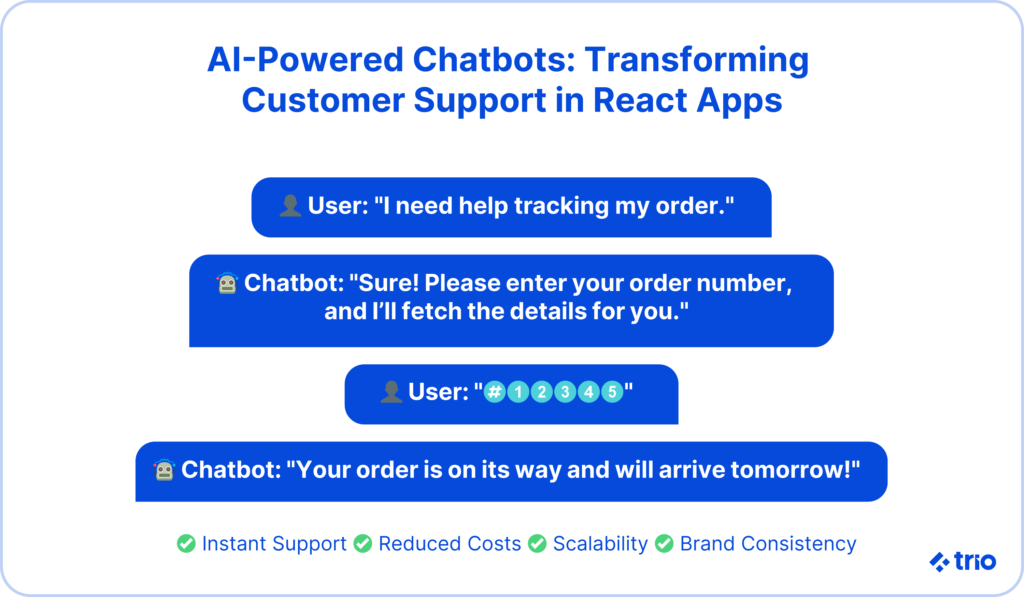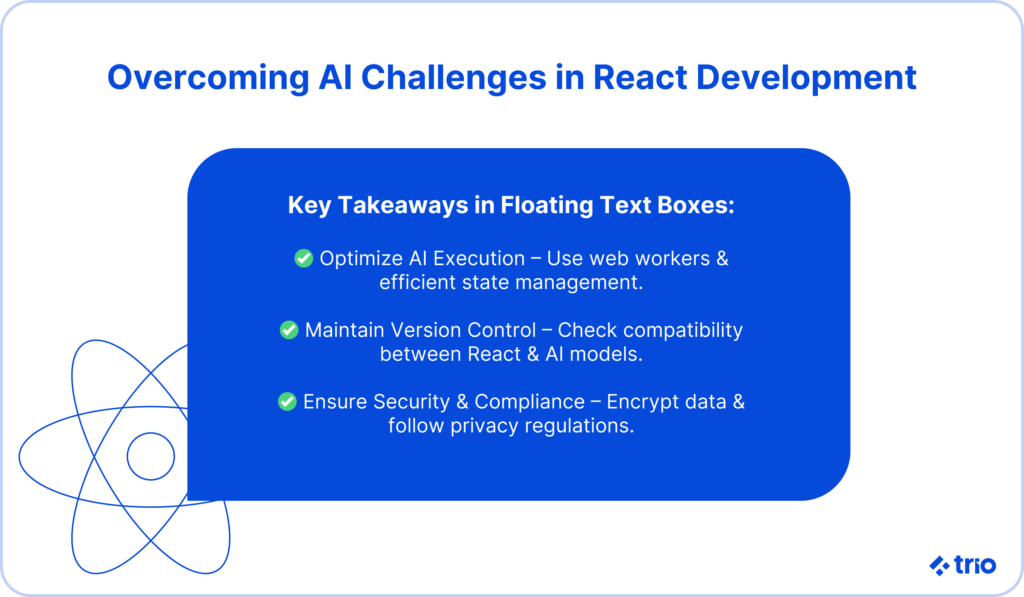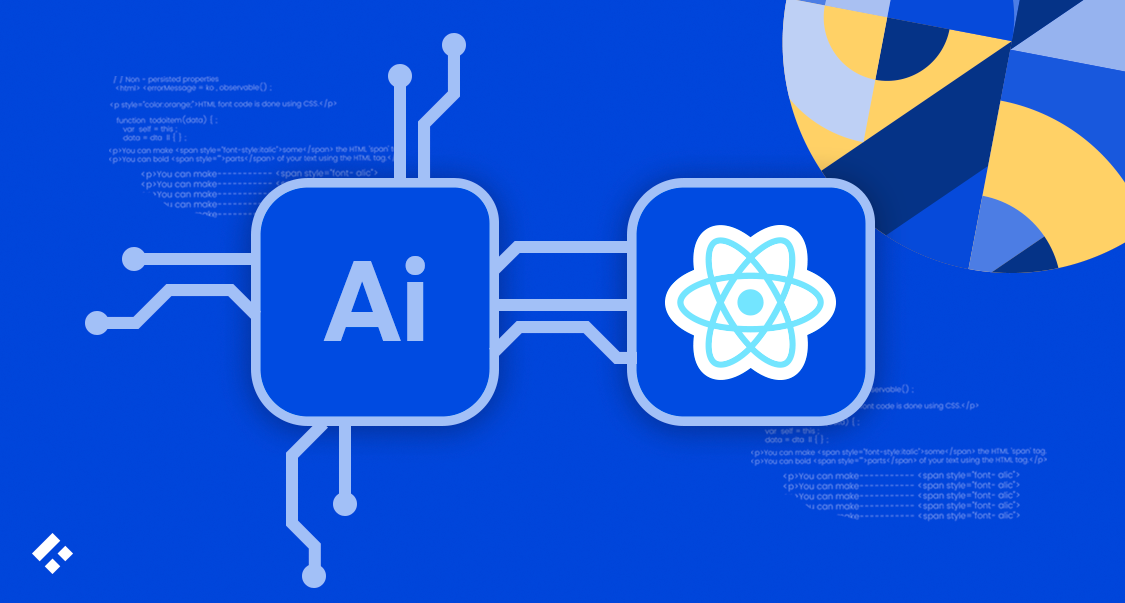AI is everywhere! Truly becoming popular since the rise of OpenAI released ChatGPT, we’ve seen it progress from the most basic generative systems and large language models to massive systems that can integrate seamlessly with existing processes to complete work quickly and accurately. So how can you integrate AI with React web development?
AI can do a myriad of different tasks for your React.js and even React Native apps. However, the process of integrating these AI models can be quite daunting. If you make a mistake in the integration process, not only will your new AI functionalities underperform – if they work at all – but you will also risk breaking the rest of your React code.
In this article, we’ll cover how you can get started with integrating AI and machine learning models in React applications. However, if you are still unsure after going over our step-by-step process of integrating these new features, you may want to consider hiring an experienced developer.
At Trio, we offer the best developers in the industry, with many years of experience in React and AI. Through our outsourcing and staff augmentation models, you can rest easy knowing that the developers working for you have done this many times before and will be able to promote your business growth through technology.

Step-by-Step Guide: How to Integrate AI with React
Step 1: Selecting an AI Model or API
React has a wide ecosystem of libraries and tools that you may find useful, so make sure to check out some AI libraries to make sure you have chosen the best ones. It is an important decision but relatively simple; you need to consider what you are using AI for.
Here are some examples:
- OpenAI API: Ideal for text generation, chatbots, and language translation.
- TensorFlow.js: Enables running machine learning models directly in the browser, which is suitable for tasks like image recognition.
- ONNX.js: Allows execution of pre-trained models in the browser, facilitating tasks such as speech recognition.
- Hugging Face Transformers: Provides state-of-the-art NLP models for tasks like text classification and summarization.
Step 2: Setting Up Your ReactJS Project for AI Integration
Now, you need to create a new project. You can do this using Create React APP or Next.js, which will give you the server-side rendering capabilities that you will need on the back end of your app.
Then, you need to install all the dependencies you are going to be working with.
APIs are also important to decide on and install upfront. Here’s what it might look like if you install OpenAI’s GPT-3 API, which is a great option if you want to harness the power of AI for natural language processing, as mentioned above.
npx create-react-app ai-enhanced-app
cd ai-enhanced-app
npm install openai
Step 3: Implementing AI Features in React Components
Now that you have chosen and installed everything you need to, you need to use these tools to create a new component that will enhance user experience.
Some examples we have seen include chatbot components that capture user input and make use of generative AI tools to create responses or even AI APIs that process user queries and fetch responses. You could also leverage AI to handle responses further by displaying AI-generated responses within the component.
Experienced React developers will be able to use the framework, along with all the AI tools, to do this as efficiently as possible and significantly enhance user experience.
Step 4: AI-Enhanced State Management in React
State management is one of the most critical aspects of React development. It is even more so when you are trying to integrate AI in your React app. The reason for this is that AI operations usually introduce asynchronous data flows. AI and machine learning also tend to be very data-heavy in general.
For instance, think about how you would need to manage the state of AI responses and user inputs for a chatbot. This is critical to ensure a consistent and predictable UI.
Consider using libraries like Redux or Zustand (a personal favorite of some of our developers) to handle AI data.
Step 5: Deploying an AI-Powered React Application
With your new components created and a confident plan to manage data, you now need to deploy your new React app. In this step, you will need a hosting platform. Vercel, Netlify, or AWS Amplify are all popular options for web apps, but there are many more you could consider.
You’ll also need to consider environmental variables and region-dependent regulations regarding security. This will affect how you manage things like API keys and other sensitive information. Since regulations change so quickly, it might be worthwhile getting some experts on board so that you can ensure a successful launch.
You can also implement performance optimization techniques, like lazy loading and bundle size changes. Although there are many best practices that an experienced developer would implement as they develop, you can use analysis tools powered by AI to figure out where any issues may appear.
Real-World Use Cases of Artificial Intelligence in React Applications
AI-powered Chatbots and Conversational Interfaces (Natural Language Processing)
We’ve already mentioned chatbots a couple of times. This is because they really are a great addition to your user interfaces, helping you enhance user experience while also appearing more professional and building your brand overall.
Some common places you might see these conversational AI chatbots include customer support, where they handle the most common inquiries. Not only does this mean your users get an instant response, but it also means you can benefit by having fewer human agents allocated to this role, reducing your overhead, or potentially allowing you to use the employees elsewhere.

AI for Personalized User Experiences in React Apps
AI can analyze user behavior in real time. One of the many things this allows you to do is provide personalized content.
Think of the product recommendations you see on e-commerce applications. In these cases, the recommendations might be based on previous activity on the web app or connected mobile app, such as previous searches or purchase patterns. In many cases, these recommended products are also based on browsing history.
Educational content is another common place where personalization is often seen. This could be as simple as the recommendations at the bottom of a blog article.
AI-Enhanced Data Processing and Automation
One of the most cost-effective uses of AI tools is to automate tasks. Automating data processing like categorization and raging in large datasets can save you a lot of time that you may have had to pay someone else for.
AI can also automate tasks where mistakes are critical, like payroll and other aspects of fintech.
Optimizing AI Performance in React Applications
Best Practices for Reducing AI Processing Overhead
A real-time web application requires a lot of processing power. Adding AI into the mix only increases those computational demands. To prevent any issues and optimize efficiency, try to use lightweight AI models like Tensorflow.js for in-browser execution and ONNX.js for pre-trained models.
Asynchronous processing is also one of the many ways that developers can ensure seamless user interactions, as it allows AI tasks to run in the background, preventing lag.
There are also other best practices that are now an industry standard for mobile development and provide a solid foundation with which to work. Caching mechanisms are one of these standards. These reduce redundant API calls, which gives you better speed and responsiveness.
Improving AI Accuracy and Reliability
AI is only great if it is accurate and you can rely on it. Otherwise, it may be more work than it is worth. To ensure that your models stay accurate, make sure that you update them regularly. Also, consider any user feedback you are given to help you regine your models over time. Fine-tuning your models based on the information you receive will help you improve their reliability in real-world interactions.
Your developers should also ensure that they are putting error-handling mechanisms in place. This will not only help them pick up on any issues but may prevent incorrect AI responses in many cases.
Challenges and Limitations of AI in React Development
Common Issues When Integrating AI with React
We’ve already discussed how AI can increase resource consumption and make your applications slower. However, there are many tools for developers to choose from in order to mitigate this issue, including those that allow for efficient state management and AI execution in web workers.
Versioning issues could also cause compatibility issues, which you will need to look out for when updating your models.
Finally, security concerns are one of the most prominent issues when working with AI, especially in sensitive fields like finance, healthcare, and education that deal with user data. Luckily, there are many different ways you can implement encryption and secure API usage.
We recommend that you get a cybersecurity expert on your team to help you set up any best practices, maintain them, and ensure you stay compliant with privacy regulations like GDPR.

Ethical Considerations in AI-Driven Applications
AI can have biases. Usually, this results from skewed training data. You need to test your models for fairness and make sure that you have a fair dataset, allowing developers to create the most bias-free models for you.
Not everyone feels comfortable with using AI. So, in order to remain ethical, it is also important that you disclose when users are interacting with AI-generated content. Furthermore, AI should be used as a tool but should never completely replace human oversight, especially in some of the critical fields we have already mentioned.
Future Trends: AI and React JS in 2025
The Next Evolution of AI-Powered React Applications
We predict that AI will continue to add to the already incredible power of React. Whether this is in the form of tools that allow for automatic code generation or whether it is for improving user interfaces and personalization.
It seems like AI-powered frameworks are emerging every day. These do everything from optimizing rendering and state management to reducing the complexity of building dynamic AI apps.
Trends like real-time speech recognition and computer vision are also becoming more prevalent in the world of web apps. It may be a good idea to start experimenting with these AI-driven features so that you can keep up with any of your competitors.
It is also important that you focus on the developer’s well-being. This will give your dev community the capacity to keep up to date with the latest AI-powered tools and industry standards so that you can benefit from the latest developments in AI.
Here at Trio, our industry experts make a point of staying on top of any developments in the industry. Many of them are at the forefront of innovation in React and AI. If you want to connect with these developers, you are in the right place.
Reach out to us to schedule a free consultation and figure out what the most cost-effective way forward will be for you.






